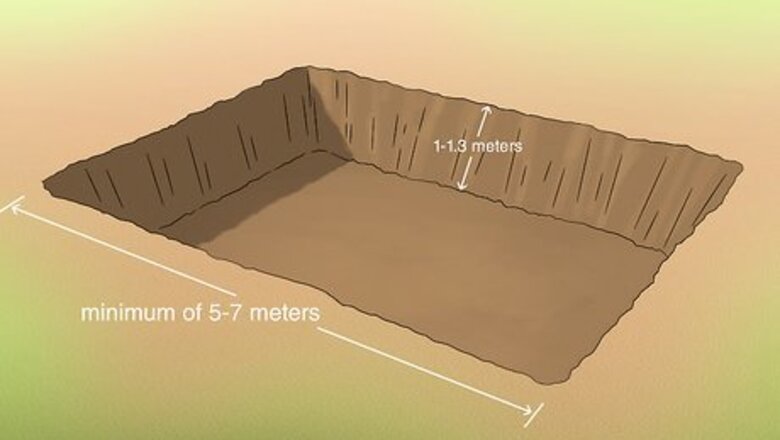
views
Building the Pond
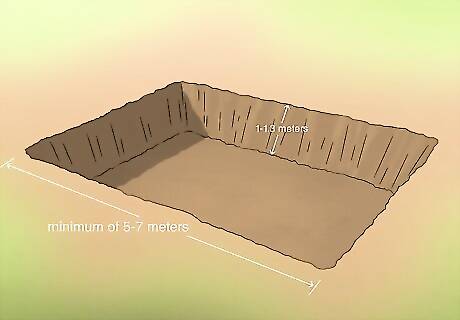
Dig out a rectangular pond. First, find ground where you'll have plenty of space but still be able to connect to your main water supply. Since you'll need a big pond to start a farm, get some friends to help dig or hire a company to excavate the land for you. Plan for the pond to be at a minimum about 5 to 7 metres (16 to 23 ft) long and wide 1 to 1.2 metres (3 ft 3 in to 3 ft 11 in) deep. Feel free to make the pond larger than this if you can install systems to properly aerate and drain it. A lot of commercial farms operate multiple large ponds. Consider adding more once you get used to managing your farm.
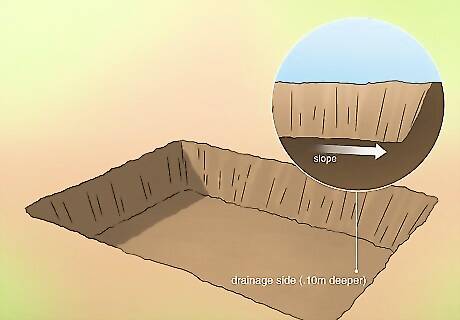
Slope the pond floor towards the drainage side. Pick out the side where you plan on installing the drainage system. For a better pond, you'll need to dig that side about .10 metres (3.9 in) deeper. Start there and dig further down. Smooth out the dirt between the deep and shallow sides of the pond to create a gradual slope.

Connect a drainage system to the pond. Building the drainage system requires more digging, so don't put away the shovel yet. Dig a trench from the water supply to one side of the pond. The trench needs to be big enough to hold and cover the drainage pipe, which emerges in the pond's floor at the base of the wall.
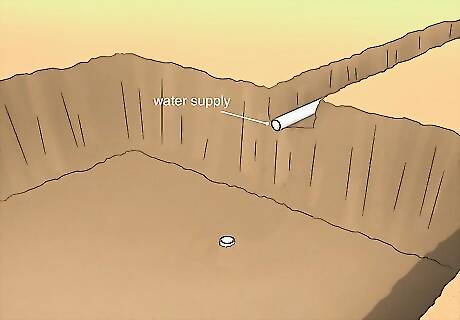
Install a water supply system. Spare yourself some digging by laying the supply pipe next to the drainage pipe. A water supply company can take care of the hardest parts for you, such as negotiating building codes in your region and setting up functional valves. When it is finished, you'll be able to fill your pond with fresh water whenever you need.

Incline the pond's walls. Inclining the walls requires a little extra work, but it's worth it in the long run. The pond needs to form a V-shape. To do this, pack another .5 metres (1 ft 8 in) of dirt on the side walls on the pond's drain side. Using your shovel, dig and smooth out the walls so they slope to the pond floor. Slope all the pond walls so you don't have to walk through water puddles when harvesting crayfish later.

Compact the soil by spraying it with water. Forcing air of the soil makes your pond less muddy during harvesting. Get a hose and spray the entire pond floor until puddles start forming. Leave the pond alone for an hour, then water it again until puddles form. When you notice that the water drains slower than usual, smooth the soil with a lawn roller. Spreading some gravel over the dirt can help keep your pond compacted after you've begun using it. Businesses that are accustomed to laying concrete can help you settle the dirt too.
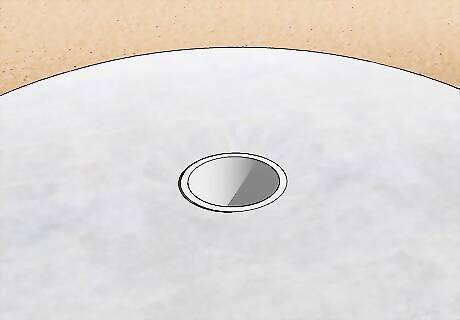
Build a concrete harvesting base around the drain. Dig out a circle a couple of inches or centimeters around the drainage pipe opening. If you have a flow trap, use it to gauge how far the concrete needs to spread. You'll have to mix concrete, pour it around the drain pipe opening, and smooth it out with a trowel or hoe. Make sure the drainage pipe isn't covered. The concrete should rise slightly above it so water flows into it.
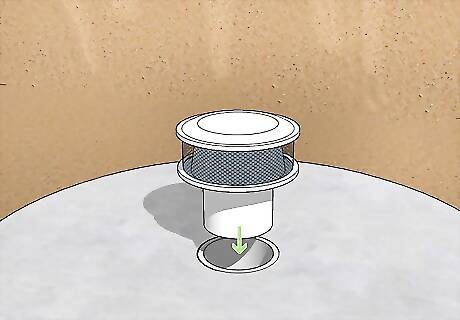
Set the flow trap over the drainage pipe. The flow trap is basically a mesh cylinder that rests around the concrete. Order one at a farming supply store and plant it firmly around the concrete. When you drain the pond, it'll stay in place and block the crayfish as they follow the water.
Establishing a Healthy Pond
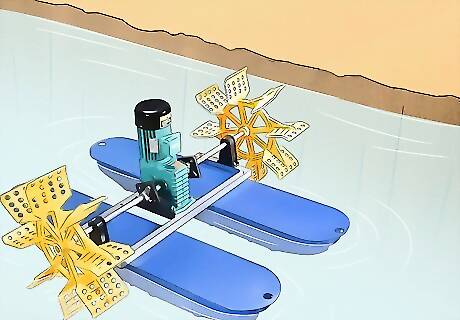
Install aeration devices in the pond. Paddlewheels are the easiest way to keep the pond aerated, which keeps the crayfish healthy. Buy them from home improvement stores. To install the paddlewheel, assemble it according to the instructions and float it in the middle of pond. Turn on the power button to run the motor. Many of them operate on gas or electricity, although you can find ones that use wind or solar energy. For larger ponds, you'll need two or more paddlewheels set in the middle of the pond. This can also be helpful in case one of them fails. Aspirators can also be used, although paddlewheels are more effective for the size of pond needed by crayfish farms.

Aerate the pond every day. To give the crayfish plenty of oxygen, turn on the paddlewheels and let them go for about 30-60 minutes. This is especially important during the summer, since warm water holds less oxygen. You can do this up to three times a day to ensure the pond stays oxygenated.
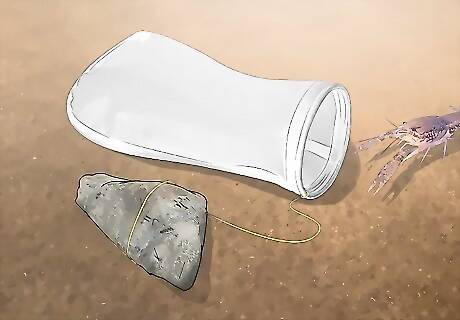
Make hiding spots out of netting. Crayfish use hiding spots during the day and when shedding. Cut open some nylon sock bags and anchor them with stones so they sink to the bottom of your pond. The nylon can also be wrapped around materials such as rocks, sticks, or plants. Set them in the center of the pond so the younger crayfish find them. You'll need about 150 hiding spots per 1,000 square metres (11,000 sq ft) of pond space. Be careful when filling the netting with degradable material. Avoid material that leaches toxins into water and change out plant matter when it starts decaying.
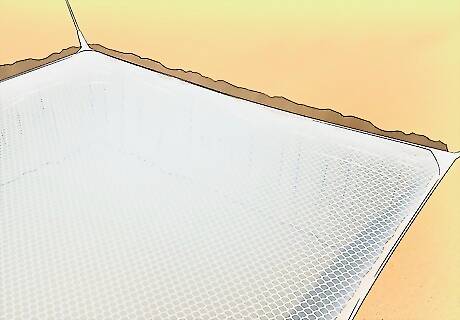
Keep the pond covered with bird netting. The last thing you want to see is a bird or forest animal pick on your crayfish. Buy a pond net at a home improvement store or hire a company to install a custom one. Set metal stakes atop the pond's walls and spread the net across the pond. Make sure to lower the net to the dirt so animals can't slip under it.
Stocking and Harvesting Crayfish
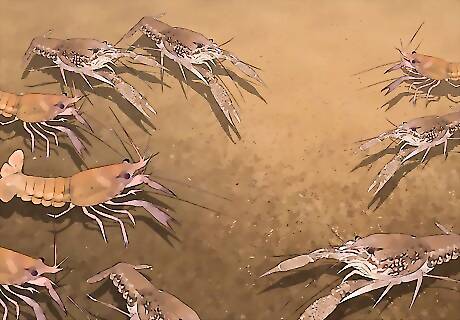
Stock the pond with mature crayfish. It's finally time to fill your farm. You'll most likely need to purchase healthy stock from another farm in early spring. Aim for about 1500 crayfish per 1 hectare (2.5 acres). Ask the farm for at least four males for every female. If you want to fish for your own crayfish, consult your local laws to make sure it's legal to capture and transport them.
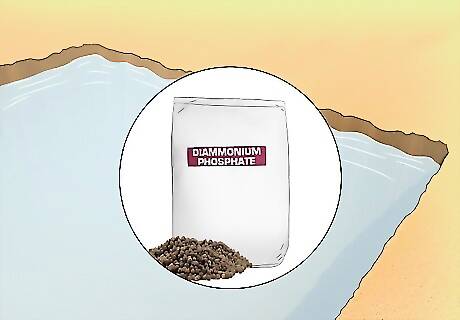
Feed the young crayfish plankton. Juvenile crayfish require a different food source than the adults. Fortunately, nitrogen and diammonium phosphate, which facilitate plankton growth, are commonly available at home and garden stores. You'll need about 50 kilograms per hectare (45 lb/acre) to start and have to add more after draining the pond.
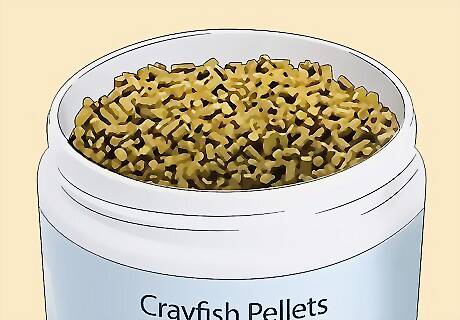
Feed grown crayfish pellets once a day. Commercial crayfish pellets are the best option and will lead to larger crayfish. However, many farms depend on other pellet types, mainly pellets made out of fish or greens, including shrimp pellets or Lucerne. Spread the pellets atop the water at dusk when the crayfish start getting active. Crayfish tend to do a little better if you give them some meaty food in addition to their pellets.
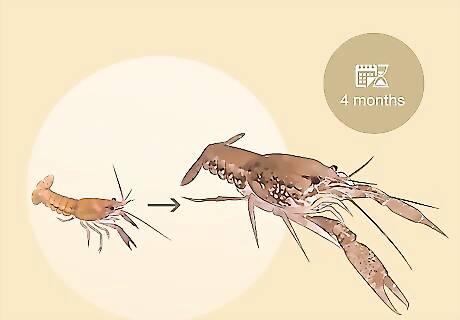
Wait four months for the crayfish to grow. After several months, the crayfish will be ready for harvesting. Until then, the young ones can be safely left with their parents, as long as you give them plenty of mesh netting hiding spots. These can be made from nylon sock bags and wrapped around material such as sticks to shield the vulnerable crayfish.
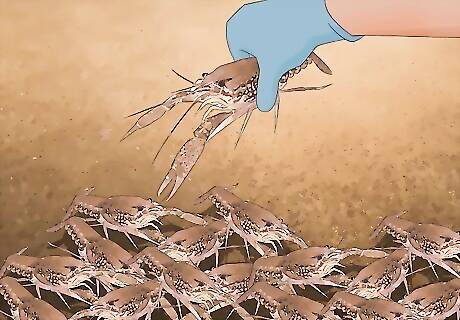
Harvest the crayfish by draining the pond. Flip on your drainage system and watch the crayfish gather near the flow trap. Because you did all that extra work digging the pond properly, harvesting is very easy. Put on your boots and gather the crayfish by hand into a water-filled tank. Don't forget to shake out the nets to find any lingering crayfish!
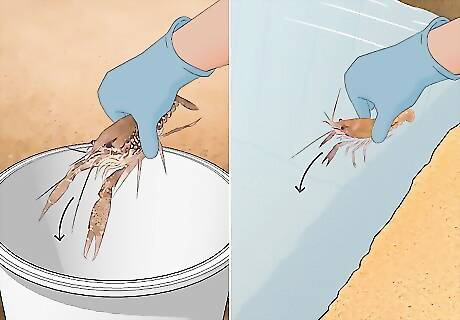
Separate the young crayfish from the old stock. The younger crayfish look small and gray. If they were left in the same pond as the older crayfish, separate them out by hand. The older ones can be eaten or sold, but the younger ones should be reintroduced to your pond to restock it again.

Avoid leaving crayfish in tanks for long periods of time. Crayfish don't do well in tanks. Often, the water isn't prepared for their needs and they can injure each other. When you have to remove crayfish from the pond, make it fast. Ensure that the crayfish are in tanks that have oxygenation systems in place. Get them to their next location as soon as possible. Transport the crayfish from the pond in a water tank. Avoid overloading the tank with crayfish and remember that they'll run out of oxygen if you leave them in there too long.
Maintaining the Pond
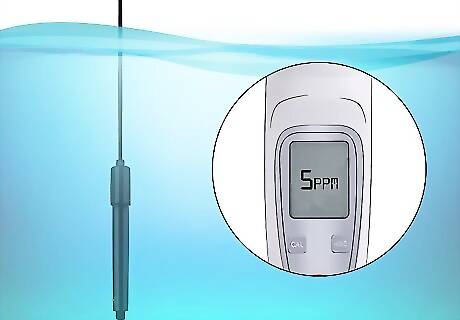
Test the water oxygen level regularly. Periodic testing is necessary to keep the water optimized for your crayfish. Pick up water testing strips or a handheld oxygen meter from a pet store or home improvement store. If the oxygen level is under 5 milligrams per litre (1.8×10 lb/cu in) or 5 ppm, you'll need to add more aeration systems, such as additional paddlewheels.
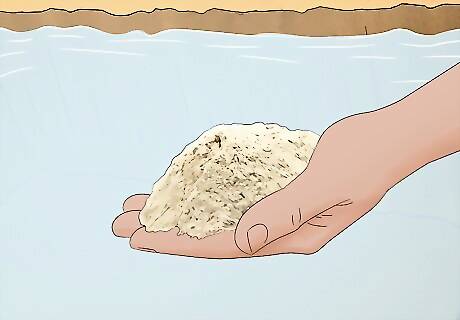
Add calcium product to keep crayfish healthy. Crayfish need calcium to build their shells. When the water is tested, the calcium level should read between 20-30 20 to 30 milligrams per litre (7.2×10 to 1.08×10 lb/cu in). When needed, buy lime from a garden store. Mix it with water in a bucket and pour it into the pond. It's best to do this gradually or before filling the pond with water since it can significantly change the pH level. A calcium level above 5 milligrams per litre (1.8×10 lb/cu in) is enough to keep your crayfish alive.
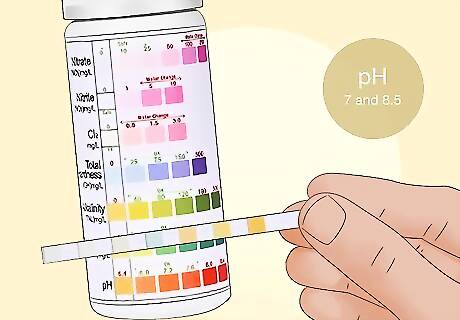
Perform routine pH testing of pond water. At least once a year, test the pond's pH level with a kit from a home improvement store. As long as the pH level stays between 7 and 8.5, your crayfish will stay healthy. An abnormal pH level could be a sign of decaying plant matter that needs to be removed.
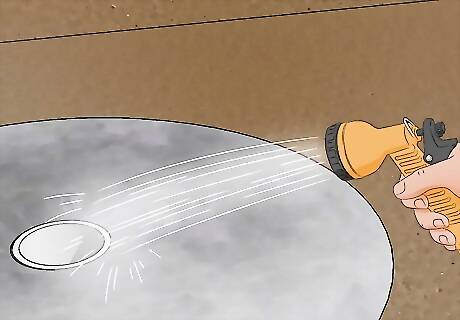
Hose down the pond whenever you drain it. Draining the pond reveals the debris left behind during farm maintenance. Get a strong hose and blast the sludge with water before scooping it out with a pond net. Sludge takes up pond space reduces water oxygen, so remove it before it builds up. Clean out the pond at least once a year.




















Comments
0 comment